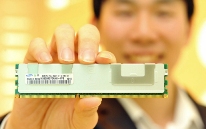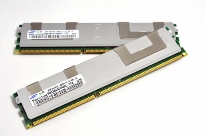
Con il comunicato stampa di seguito allegato, Samsung Electronics ha reso noto di aver avviato le consegne dei sample dei primi moduli di RAM RDIMM al mondo aventi una capacità pari a 32GB.
Si tratta di soluzioni di tipo DDR3 (cfr. le foto seguenti), che integrano chip di DRAM realizzati con un processo di fabbricazione a 40nm, destinate all'ambito server; oltre alla elevata capacità, i nuovi moduli possono vantare da un lato alte prestazioni e dall'altro un ridotto consumo di potenza.
Nel caso dei sistemi di tipo dual-cpu, con questi moduli RDIMM da 32GB è possibile realizzare delle configurazioni che includono fino a 384GB (12x16GB) di memoria centrale; in accordo al produttore, in tal caso l'incremento della potenza assorbita, rispetto al caso di un server dual-cpu equipaggiato con 192GB di RAM ottenuti con l'ausilio di 12 RDIMM da 16GB (ovvero il massimo della generazione sul mercato), è pari soltanto al 5%.
La produzione in volumi dei moduli RDIMM da 32GB sarà avviata nel corso del mese di Aprile

[Immagine ad alta risoluzione]

[Immagine ad alta risoluzione]

SEOUL, Korea - March 29, 2010 – Samsung Electronics Co., Ltd., the world leader in advanced memory technology, announced today that it has begun shipping samples of the industry’s highest-density memory module for server systems. The 32 gigabyte (GB) module has been designed for use in advanced servers, which require high-density and high-performance features at low-power consumption levels.
According to Soo-In Cho, president and general manager of Samsung Electronics Memory Division, “Samsung continues to set the pace in advanced memory for high-end server applications by offering 40nm-class 32GB memory modules to reach previously unattainable levels of system capacity.In just 10 months, Samsung has now secured the best competitive advantage with the broadest portfolio of 40nm-class DDR3 based memory solutions in the industry since the 40nm-class DRAM was first produced last July.“
“Technology leadership is a key factor in Samsung’s aggressive competitiveness within the memory industry,” Mr. Cho emphasized, “Our highly successful implementation of 40nm-class technology is indicative of our determination to move toward the 30nm-class process node in the second half of this year. Our 30nm-class technology will provide even more advanced memory solutions for high-end server and PC applications”.
Samsung is using the industries highest-density monolithic DDR3 device – a 40-nanometer (nm) class, four gigabit (Gb) DDR3 chip – as the building block for the new 32GB module. This comes just one year after the company announced its 50nm-class 2Gb based, 16GB registered dual inline memory module (RDIMM) last March.
The highly-efficient 32GB RDIMM consists of 36 dual-die 40nm-class 4Gb DDR3 chips that can perform at equal or greater levels to a 40nm-based 16GB RDIMM with no increase in power consumption.
By equipping a dual CPU, two-way server with 32GB modules, a server system can have up to 384GB of memory. This allows for doubling the previously largest density of 192GBs per server with a power increase of less than five percent over that needed for a 16GB module-based system.
In addition, replacing 12 DRAM modules of 16GB density with just six 32GB modules would achieve a 192GB total density, while allowing the DRAM operating speed in a two-way server system to rise by 33 percent from 800 megabit per second (Mbps) to 1,066Mbps, as power is cut by 40 percent.
In high-performance, four-way servers using 16GB modules, one terabyte of DRAM would be commonplace.By using 32GB RDIMMs, Samsung is moving toward providing four-way servers with 2TB of DRAM each, a migration that it believes will spur introduction of diverse software and a broader scale of server applications.
Mass production of the 32GB RDIMM is slated to begin next month.
For more information about Samsung Green DDR3, visit www.samsung.com/ddr3
Source: Samsung Electronics Press Release
Links



